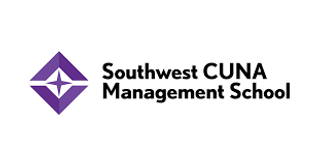Southwest CUNA Management School (SCMS) transitioned their in-person executive training program online in a matter of months with the help of Canvas LMS. The easy-to-learn LMS, coupled with SCMS’ intentional curriculum redesign, resulted in 80 percent of learners recommending blended learning moving forward.
The Challenge
Hands-on. On-campus. In-person. A highly personal experience is the hallmark of Southwest CUNA Management School (SCMS).
SCMS is a three-year executive training program for credit union professionals, located on the Texas Christian University campus. One of four regional schools in the Credit Union National Association (CUNA) system, SCMS enrolls credit union leaders from multiple states, with the occasional international student.
Professionals at SCMS gain hands-on management training, develop strategies for their credit union’s growth, and build a broad professional network. This network is what SCMS alumni treasure most, said Director Janine McBee.
With 160 hours of live, in-person training a year, virtual learning was virtually non-existent at SCMS. Faculty had varying levels of learning management system (LMS) experience. Professionals, ranging in age from 20-60, also represented a wide range of technological expertise.
Key Insights
With small cohorts of 50 professionals, the SCMS executive training experience is highly personal and, until the pandemic, provided 160 hours a year of on-campus, in-person learning. To transition to virtual learning, the school chose Canvas LMS because it allowed for rapid, seamless deployment and was easy to learn for users with no LMS experience
The pandemic forced SCMS into remote learning, while providing the opportunity for a complete curriculum overhaul. Administrators intentionally redesigned 50 courses for a virtual, mobile experience.
“Growing a network for a lifetime” is a key selling point for SCMS. The school used Canvas’ robust communication tools to virtually facilitate networking among learners, faculty, and alumni
The Solution
To pivot to virtual learning, SCMS needed an easy-to-learn, easy-to-deploy LMS. When they found Canvas, McBee said it was an “easy decision.” What attracted them? Canvas was a solution that a “someone with no background could learn rapidly,” McBee said. And rapid it was. Administrators and faculty had about five months to transition all course material to Canvas.
I don’t see comfortable places anymore. We will be evolving and moving forward on a regular basis. We’re writing a new
playbook.
Janine McBee
Director, Southwest CUNA Management School
Mobile and Micro
Having all course materials, communication, and assignments on one platform made for a seamless transition, McBee said. Accessing it all on a mobile device was an unexpected bonus. “Having the mobile app is what kept us in function mode,” McBee said. “I didn’t have anyone who couldn’t access a course. It gave the students options.”
Going virtual wasn’t a matter of simply digitizing lectures. “We didn’t want to take eight hours of classes and make it an eight-hour day on Zoom. That is excruciating,” McBee said. So SCMS seized the opportunity. As McBee put it, “we blew up the curriculum.” The team intentionally redesigned 50 courses for a virtual experience.
Instead of lengthy lectures, SCMS chopped up content into bite-size pieces. Microlearning courses on credit union fundamentals like key ratios gave users a “safety net” to review content on Canvas — anytime and anywhere — instead of leaving a physical classroom without grasping concepts. This mobile and micro strategy gave executives autonomy and flexibility in their learning path.
McBee said.SCMS also tapped into its alumni network to help with the transition. Alumni served as ambassadors to the new all-remote cohorts, to support the classes but also be eyes on the ground for administrators
“If I’m honest, I was not sure how it was going to work. The SCMS team did an excellent job creating a space for true learning to take place each day,” an alumni said.
Virtual Networking
If networking was a key selling point for a SCMS experience, how could the school replicate it online? McBee said faculty leveraged Canvas discussion boards for engagement activities before instruction began. One “getting to know you” discussion prompt led to over 600 posts from just 58 learners. These activities humanize the peers behind the screen.
Using Canvas, SCMS redesigned their curriculum to be more mobile and bite-sized, giving executives flexibility to learn anywhere and anytime. This autonomy is essential for corporate learners navigating work and study simultaneously.
The Results
Flipping an in-person, highly personalized program to an allvirtual environment was no small feat for SCMS. Survey data shows it was worth the work — 92% of SCMS learners said their first virtual year went “great” or “better than expected” and over 80% recommended a blended learning environment. Even without in-person learning, 92% of enrolled professionals said they expanded their network. Moving forward, the school plans to continue with a blended learning environment with Canvas as their classroom hub.
Download Case Study



